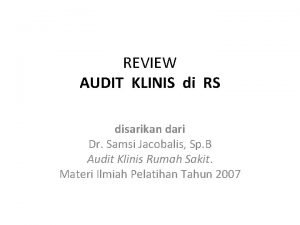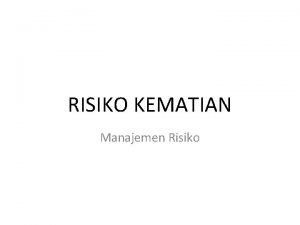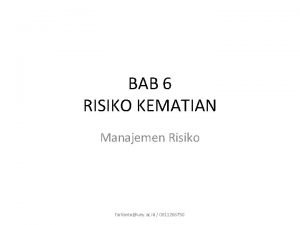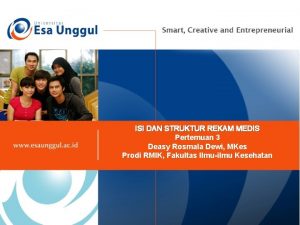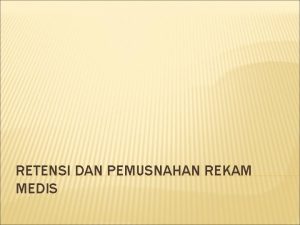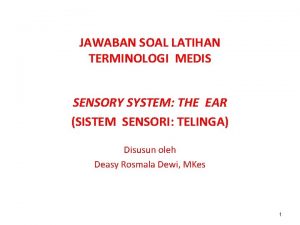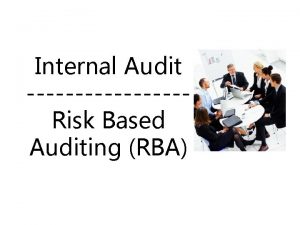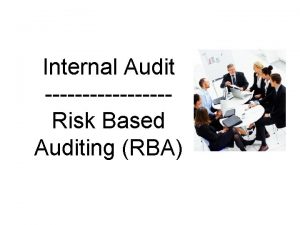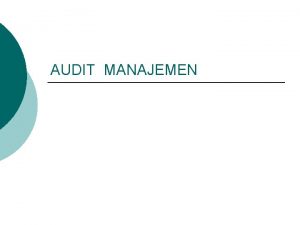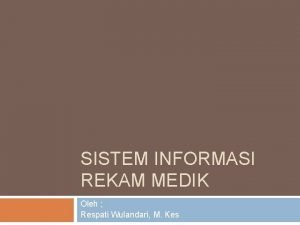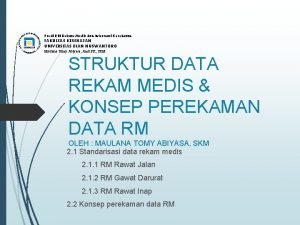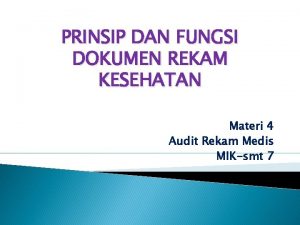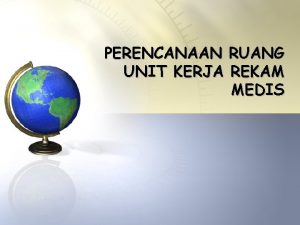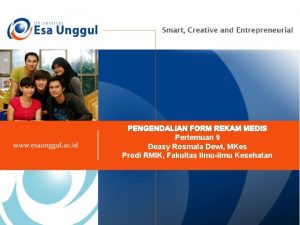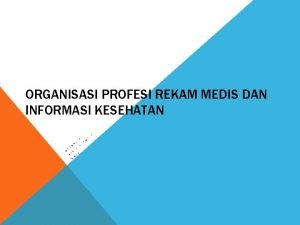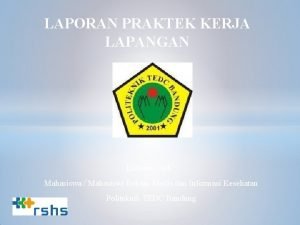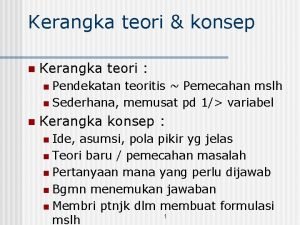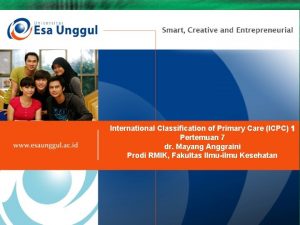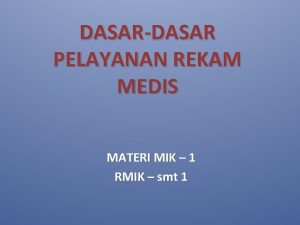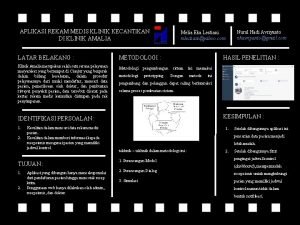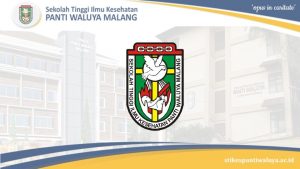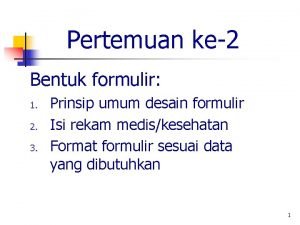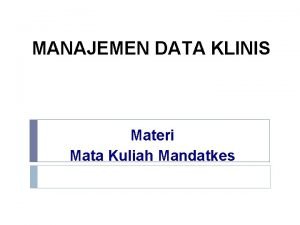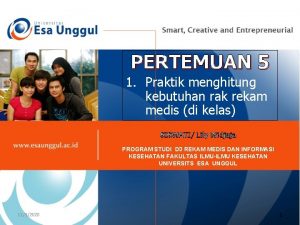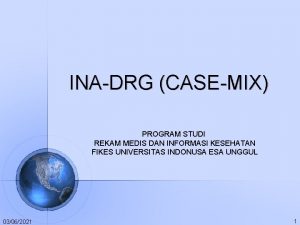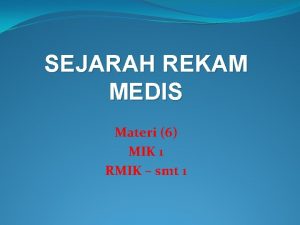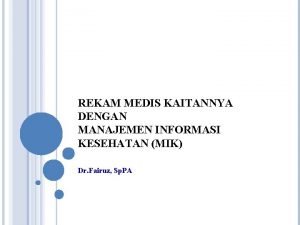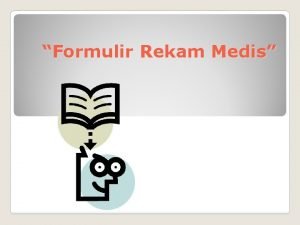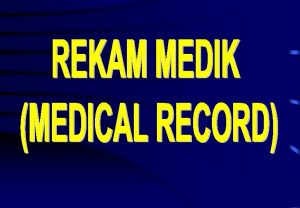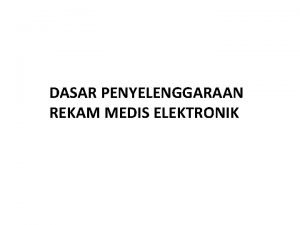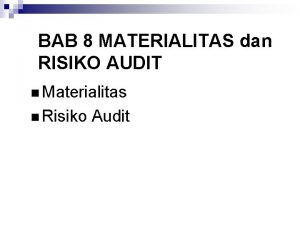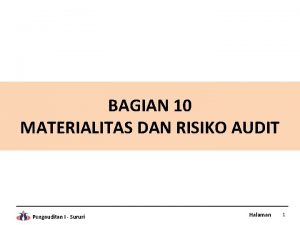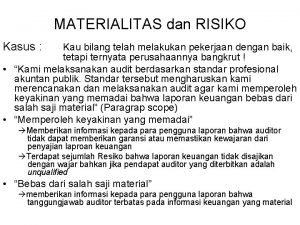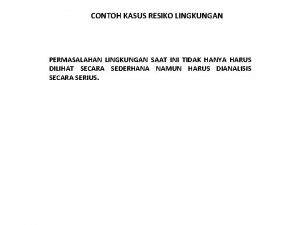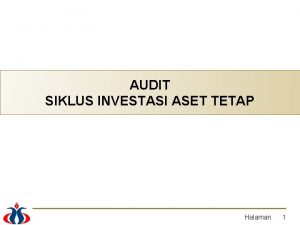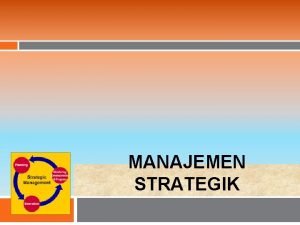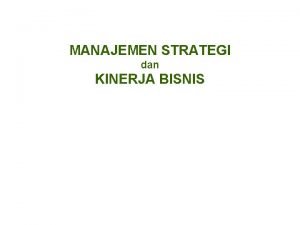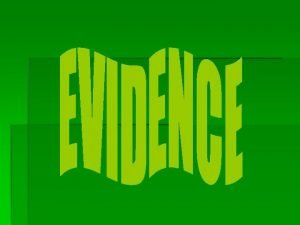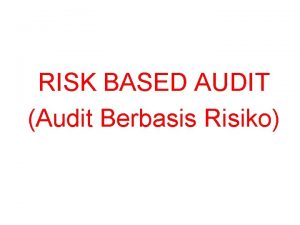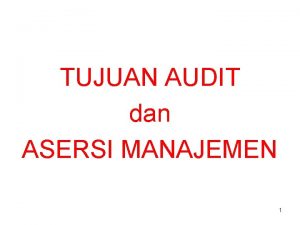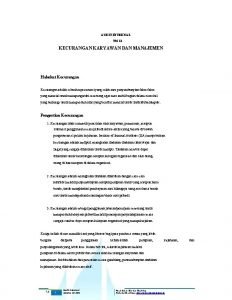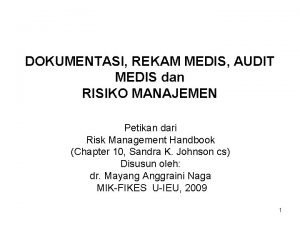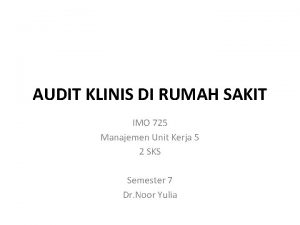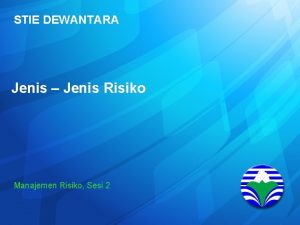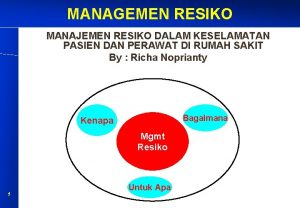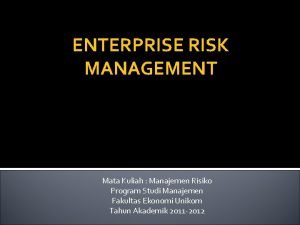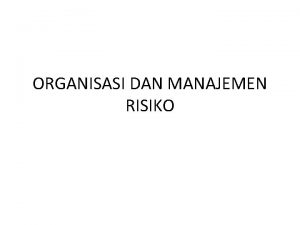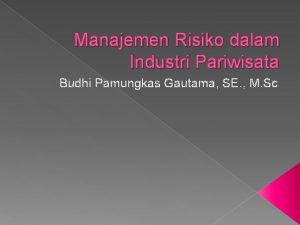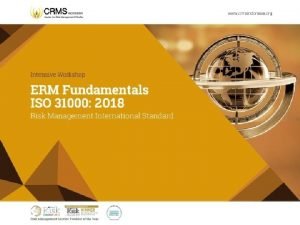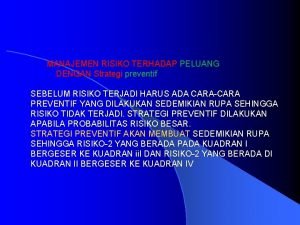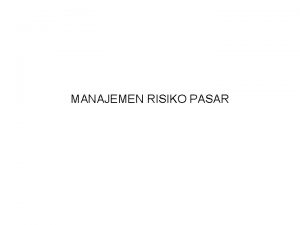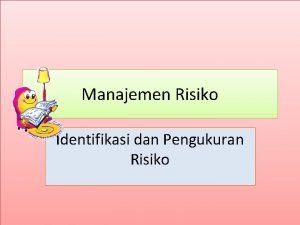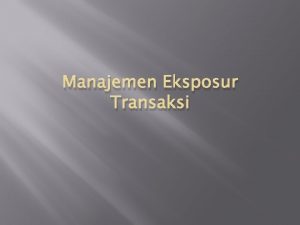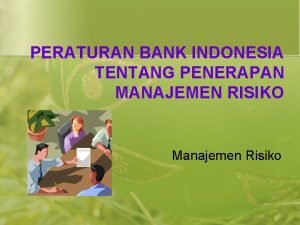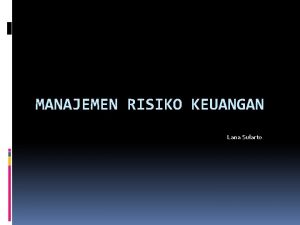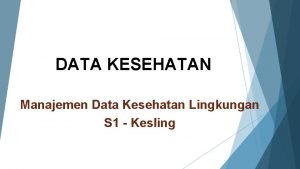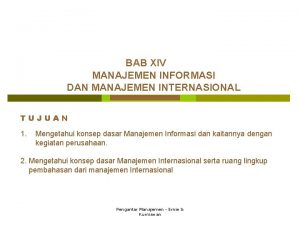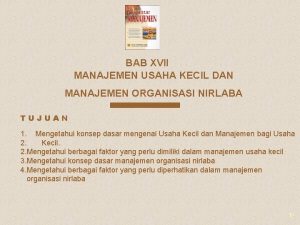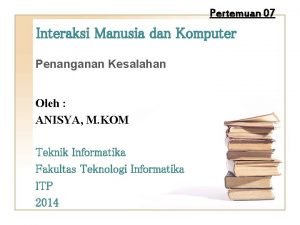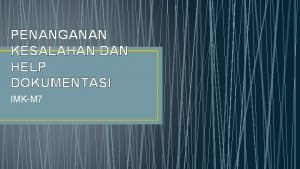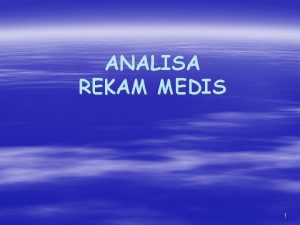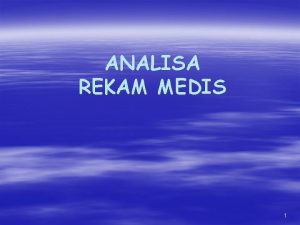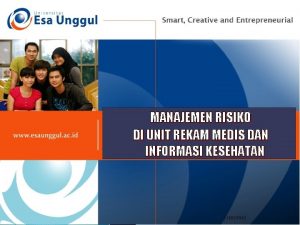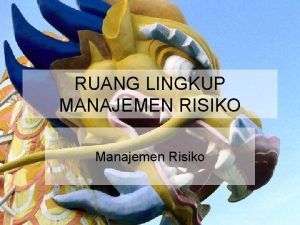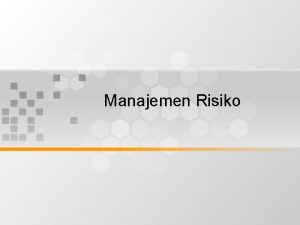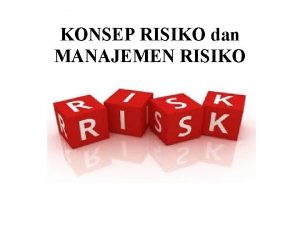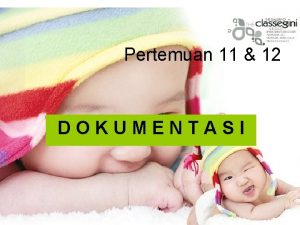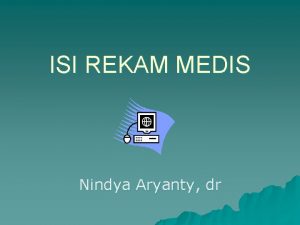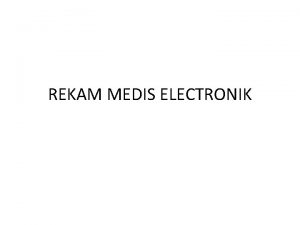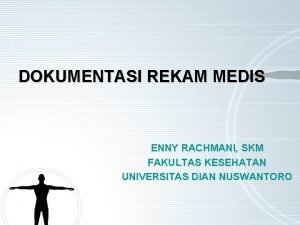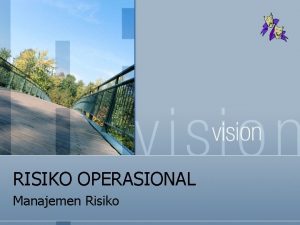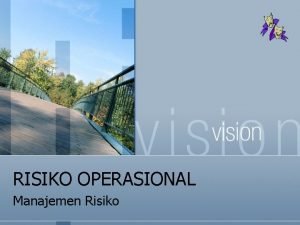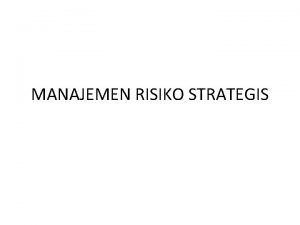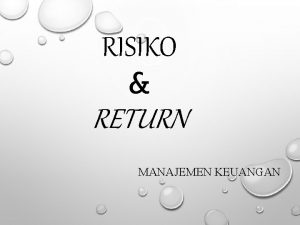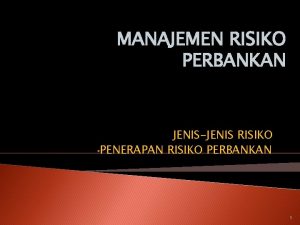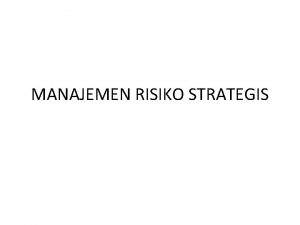DOKUMENTASI REKAM MEDIS AUDIT MEDIS dan RISIKO MANAJEMEN


















































































- Slides: 82

DOKUMENTASI, REKAM MEDIS, AUDIT MEDIS dan RISIKO MANAJEMEN Petikan dari Risk Management Handbook (Chapter 10, Sandra K. Johnson cs) Disusun oleh: dr. Mayang Anggraini Naga MIK-FIKES U-IEU, 2009 1

SAMPLE RULES OF DOCUMENTATION CORRECTING ERRORS in the MR The acceptable method for correcting an error is: to draw one line through the entry, initial or sign it, and date it. Then place the correct information above the draw-through entry. 2

Apabila Tidak Ada Tempat Tersedia untuk Menulis Perbaikan: If space is not available or if the corrected informastion is too lengthy to place adjacent to the incorrect entry, the corrected note should be placed in the appropriate place on the record and it should be contemporaneous with that date’s notes. (contemporaneous = sejaman, sebaya) 3

Sample Rules of Documentation (Cont. -) It should dated and signed and the reason for the correction noted. Never obliterate, erase, or use correction fluid, as these methods of correction may appear to be an attempt to conceale the entry. It is strongly recommended that nothing be added to the record after an adverse outcome, patient complaint or request for records. 4

Hearsay The risk manager should advise staff that “hearsay”, or statements made by persons other than the auther of the entry, should not be documented as if they were fact. Instead, the method by which the author of the entry heard the statement and the fact that it was heard from another source should be documented, and the actual statement made should be documented in quotation marks. 5

Telephone Calls & Telephone Advice in Physician Office Practices It is recommended that medical advice not be given over the phone unless it is known who is on the other end. However, this is a fact of life for the physician who recieves calls from patients. All health care organizations should have clearly documented policies governing who may give what type of advice over the phone other than the physician. In those instance when medical advice is provided, documentation is imperative. 6

Tetephone Calls. . (Cont. -1) Emphasis should be placed on those organizations or areas that are more prone to recieve patient calls, such as: outpatient clinics, physician offices, home health agencies, and emergency departments. Patients often call their physicians’ office during the day or after hours. A duplicate phone message pad (even at the bedside at home) is one way to keep a back-up log of who called, date and time, and reason. 7

Tetephone Calls. . (Cont. -2) In the clinic or office, the original copy should go to the physician to return the call and the conversation added to the note for filing in the patient’s MR. Such documentation will reflect: the initial reason for the call, - the further description of the problem as described to the physician, and - the physician’s response or recommendation. 8

Tetephone Calls. . (Cont. -3) Documentation of this information may prove to be invaluable in the event the quality of care is called into question. At a minimum: the date, time, and content of the discussion should be documented. All telephone messages must be filed in the MR in chronological order. 9

Physician Notification Whenever a call or page is made to a physician, the date and time should be carefully documented. The conversation with the physician should include the date and time if different from the call and include the content of the conversation. This conversation should include the exact signs and symptoms, lab results, and other details conveyed to the physician and the response, including additional information requested and given to the physician. Responses from the physician need to be similarly documented. 10

Phys. Not. (Cont. -1) If the situation is serious and the physician has not responded in a timely manner, the nurse must follow the: “chain of command” procedures and contact the nursing supervisor or other appropriate person, in accordance with facility procedures. In addition, notice should also be provided to the chief of the physician’s specialty. 11

Phys. Not. (Cont. -2) Regardless of the setting or the reason, when the patient care staff has a need to make contact with a physician, it is important, but in the acute-care high-risk units, sometimes time is of the essence. Each health care setting should have policies governing expected response time and steps to take if response isn’t recieved within that parameter. 12

Phys. Not. (Cont. -3) Many physicians use an answering service to take calls. In turn, the service pages the physician. The anwering service should keep a log of the time the call was recieved for the physician and the time the physician returned the call to the service. Staff who reach an answering service when calling a physician should document the name of the person taking the call and the phone number of the answering service for potential future reference. 13

Countersignature imply that the health care provider has done more than just read and sign an entry or order. Countersignature connotes that the health care provider agrees with the patient care described or transcribed. Whenever a health care provider sign an entry in a MR, he or she is responsible for whatever is contained in the entry. 14

Countersignature (Cont. -1) H&P (history & physical), operative note, admission note, and discharge summaries are often dictated and transcribed. When completing charts the physician signs these transcribed documents, authenticating the contents. 15

Countersignature (Cont. -1) As often as possible, the risk manager should emphasize to the medical staff the significance of reading, verfying, and correcting transcribed notes before authenticating them with their signature. 16

Countersignature (Cont. -1) Those who use e-MR should be assigned electronic signatures, which should never be given to anyone to use; for instance, the radiologist should not give the electronic signature to the radiology transcriptionist so the step of verifying and authenticating the transcription is bypassed. In some states (USA) this could be construed as fraud an offense reportable to the state licensing board. 17

Countersignature (Cont. -2) CMS (USA) requires documentation of verbal orders or entries requiring countersignatures be signed as soon as possible. One physician cannot sign for another, unless both share joint responsibility. Facility policies and medical staff bylaws should define wether documnettaion by house staff and allied health professionals requires countersignatures. In some instances this is governed by specific state law. 18

Abbreviations The use of abrreviations saves time; however, they may be misinterpreted if they are ambiguous. Health care providers should be instructed to use universally accepted, standard medical abbreviations and those specifically approved by the individual health care facility. Abbreviations can vary by setting. For those facilities employing traveling nurses, there needs to be a way for all providers to have the same understanding where abbreviations are concerned. (use of abbreviations to prevent medication errors). 19

Authentication (USA) JCAHO provides that entries in MR may be made only by individuals given that right, as defined in facility policies and procedures and medical staff bylaws. All entries should be dated and signed by the auther. In addition to the full name, the professional title should be reflected, such as MD (medical doctor), PA (physician’s assistent), APRN (advanced practice registered nurse), RN (rfgistered nurse), and so on. It is suggested that policies, procedures, and bylaws be recieved to ensure there is no conflict among these authorizing documents. JCAHO will survey a facility’s performance against its own guidelines, and discrepancies can result in Type I recommendations. 20

Documentation Of Termination Of Care When dealing with non-compliant patients and families (those who fail to follow instructions on: diet, medications, use of safety devices, or who tamper with medical equipment), the risk manger should advise staff to thoroughly document these issues objectively, including all education and reinforcement provided. 21

Documentation Of Termination Of Care (Cont. -1) In the event it becomes necessary to: - “administratively or permanently discharge” or - refuse further care, the usual practice is to orally advice the patient and family of the intent to do so, followed immediately by written notice, sent certified mail, and return receipt. This written notice should give a timeframe (usually thirty days) for continued care (sometimes limited to emergency care during the timeframe). 22

Documentation Of Termination Of Care (Cont. -2) Included should be either: prescriptions for the timeframe (thirty days) - or a reference that if a refill prescription is needed during the thirty days it will be provided. It should also include referrals for continued care, such as several names and phone numbers of physicians in the same specialty and the name and phone numbers of the local or regional medical and osteopathy (DO) societies. 23

Documentation Of Termination Of Care (Cont. -3) Remember to keep a copy of correspodence with the patiient for your file and the patient’s MR. It is recommended that the risk manager check with legal counsel to verify that such a tremination process somplies with specific state statutes and case law. 24

RECORD RETENTION How long a record should be kept is dependent on factors such as: - Statute of limitations Individual state statutes 25

Standards and Regulations • Those that have MR retention requirements include, but are not limited to: a) JCAHO b) CMS: for hospitals, home health agencies, state and long-term care facilities, comprehensive outpatient rehabilitation, organ procurement, rural primary care. c) Occupational Safety and Health Administration (OSHA) d) The Public Health Service Act: Immunization Program and National Childhood Vaccine Injury Act e) The National Commission on Correctional Health Care for Health Services in jails and Prisons 26

RECORD RETENTION (Cont. -1) • Federal reimbursement requirement guidelines • Institutional record retention policies. Clear and complete recordkeeping guidelines must be developed and implemented for every health care organization. While most records are maintained in one location, recordkeeping guidelines should also address all departements that maintain separate files. In addition, recordkeeping guidelines must address the review of all medical records shortly after the patient or resident is discharged, to ensure that the record is complete. Records that are involved in pending or threatened legal action should be segregated. 27

RECORD RETENTION (Cont. -2) • Destruction of patient health information is carried out in accordance with federal and state law and pursuant to a proper written retention schedule and destruction policy approved by the: - health information manager, - chief executive officer, - medical staff, and - legal counsel. Records involved in any open investigation, audit or ligitation should not be destroyed. 28

RELEASE OF RECORDS Records should be released only as authorized by state and federal laws, as well as the organization’s policies and procedures. Policies and procedures for release of MR should address: - Who may request and secure a copy of a patient’s MR (in the acute-care setting, it is most often the patient or authorized representative who requests the record; in the long-term care setting, it is more often the resident’s Power of Attorney guardian, or surrogate) 29

RELEASE OF RECORDS (Cont. -1) - Who is authorized to release records and to whom (such as: patients, another staff member, attorney, insurance company representatives) - How acces to MR is monitored and documented ? (who checks out and returns records and when) 30

RELEASE OF RECORDS (Cont. -2) Appropriate mechanisms to protect sensitive patient and employee health information, such as: informtaion related to HIV results, lifestyle, substance abuse, psychological profile or behavioral health records Failure to follow proper release procedures can result in significant liability. 31

RELEASE OF RECORDS (Cont. -3) In order to minimize opportunites for liability, records should not be removed from the central location. Alternatively, only a copy of the record should be released so that the original records are always maintained within the records retention area. 32

OWNERSHIP OF MEDICAL RECORDS The MR is an unusual type of property, as both the patient and the health care facility or provider have an ownership interest. The health care facility or provider owns the actual record, but The patient owns the information contained therein. 33

OWNERSHIP OF MEDICAL RECORDS (Cont. -1) The record must remain in: the facility or doctor’s office; therefore, The facility or office has the responsibility to exercise control in the release of the document itself or the information contained therein. 34

OWNERSHIP OF MEDICAL RECORDS (Cont. -2) Patients and others who have a vested interest have a right to access the information contained in the record; but there are limitations on this right, which vary by state. In today’s environment, MR ownership issues arise relative to mergers, aquisitions, divestitures, and HMO provider contracts. 35

MEDICAL RECORD AUDIT Compliance with documentation standards and expectations can be verified through regular MR audits. MR may be audited by examining the following organizational processes: 1) Is the reason for the patient encounter documented? 2) Is there a process to verify that services that are provided are documented? 36

MEDICAL RECORD AUDIT (Cont. -1) 3) Does the record clearly explain why support services, procedures, and supplies were provided? 4) Is the assessment of the patient’s condition apparent in the record? 5) Does the records contain information on the patient’s progress and on the results of treatment? 6) Does the record include a plan for care? 37

MEDICAL RECORD AUDIT (Cont. -2) 7) Does the information in the record describing the patient’s condition provide reasonable medical rationale for the services? 8) Does the information in the record support the care given in case another health care professional must assume care or perform medical review? 9) Is the documentation in complainse with established policies and procedures, as well as local, state, and federal requirement? 38

Claims & Litigation Management Condiderations A discussion of the considerations pertaining to documentation must reflect the changing demands of the health care environment. More elderly people are recieving medical care, and medical conditions are more acute. 39

Claims & Litigation Management Condiderations (Cont. ) There are constantly new procedures, drugs, and equipment introduced to provide medical care. There is more emphasis on consumers’ rights, and the media’s heightened interest attracts even further attention and scrutiny of the provision and quality of health care services. 40

Jury Relies on Documentation One only needs to attend a professional liability trial or read a malpractice case transcript to realize how much a jury relies on documentation. What the providers document or fail to document will certainly influence the outcome of any case. 41

Claims & Litigation Management (Cont. -1) Plaintiffs’ attorneys have erroneously promoted that an action that is not documented is not performed. Health care providers know that this old adage is incorrect, as much patient care is rendered that is never documented. 42

However: Documentation is especially significant in cases of: informed consent, medication, or treatment entries but is also true of “routine” observations. 43

Claims & Litigation Management (Cont. -2) - Other ways that MR can be used adversely in the event of a claim include but are not limited to: When there is no recorded continuity of the patient’s status and deterioration occurs, absence of documentatrion will be used to support a claim of negligence. 44

Claims & Litigation Management (Cont. -3) - A series of events leading up to a patient’s injury in the hospital - Failure of staff to use information avaible in the patient’s record - Failure to impart important information from one department to another - Failure to write legible medical orders. 45

Claims & Litigation Management (Cont. -3) One way for health care providers to evaluate their charting is: to view it as an attorney would and ask himself/herself, if it were presented as evidence to a jury, would it be thorough and convincing. 46

Liability Issues Specifically Concerning MR Include but are Not Limited to: • • Record authentication Record retention Record destruction Access to MR Release of confidential information Release of information in litigation Electronic record security 47

Documentation Issues that help Jurors make Decisions about Cases include: What is reasonably expected of the health care professional’s peers? What is in accordance with the standard of care ? How does it reflex upon the quality of care provided? 48

A MR can be used in the affirmative defense of a claim if it: • Documents all relevant medical information • Substantiates the rationale for care provided or not provided • Highlights the interaction between rendered • Creates a timeline for care rendered • Documents the psychosocial needs and concerns of the patient and relevant others • Preserves the medical history of patient care • Is more reliable than personal recollection. • Demonstrates good communication • Demonstrates quality medical care. 49

MR Alterations If the MR is altered, unintentionally or purposefully, it can be misleading to others, and documentation as to the actual care provided may be disputed. Falsification including alteration of MR, can be grounds for a criminal indictment or a civil claims for damages. 50

MR Alterations (Cont. -1) Even with the: best of intentions, changing inaccurate information, filling in omissions, altering dates and times, rewritting text, destroying records, adding to someone else’s notes, and correcting or amending notes can be construed as: “tampering with MRs. ” 51

MR Alterations (Cont. -2) This can expose the health care organization and health care provider to many different types of claims, raise many other issues, and, quite possibly, could result in the loss of affirmative defenses in a negligence claim Additionally, tampering may be reportable to external agencies and professional licensing boards. 52

MR Alterations (Cont. -3) All known cases of tampering should be reported to the corporate compliance officer. • The risk manager should be notified and should assist in the investigation whenever it is suspected or determined that a record has been altered. 53

MR Alterations (Cont. -4) Reports should be filed with the external licensing board as appropriate. In addition, the risk manager can assist in the preservation of records and deter alterations. Having a policy and procedure on the early sequestering of medical records after a significant incident will decrease the probability that the records will be released and altered. 54

MR Alterations (Cont. -5) If a patient experiences a poor or unexpected outcome, the urge to alter record to make the care appear more appropriate nay be overwhelming. With this in mind, the risk manager should rely on established policy and procedures (developed in conjunction with legal counsel and the medical records department) to preserve the current inuse record. 55

MR Alterations (Cont. -6) One effective way to decrease alterations is to copy the current record that discusses the poor outcome for the MR file and put the original in the “legal file” under the care and control of the MR director. The copy on the shelf is available for patient care reference. Should be original need to be reviewed or completed, a representative of the MR department should sit with the individual to prevent alterations. 56

MR Alterations (Cont. -7) Remember, it is the MR department personnel who must testify or sign affidavits to the effect that the original record has been in their care, control, and custody. Should the original record be sent to risk management or legal counsel for safekeeping, the medical records department pesonnel would not be able to make such statements. 57

MR Alterations (Cont. -8) • If this policy is consistently followed on potentially serious incidents and events, the likelihood of alterations should be prevented because no one would have unfettered access to the original record. • Usually, when a serious incident has occured the risk manager asks for copy to begin an early investigation, which would be another copy available for comparison should alterations after the fact be suspected. 58

MR Alterations (Cont. -9) For records that are stored in the MR department, it is prudent to have: a policy and procedure on the release or availability of records to requesting and appropriate parties. 59

MR Alterations (Cont. -10) Depending on the status of an identified event incident, notice of intent to sue, claim being made, lawsuit, and so on, the record could be sequestered with the original not being made available unless under direct supervision. This policy will prevent the inadvertent alterations or misplacement of the record. 60

FORENSIC DOCUMENTATION EXAMINATION • For many years forensic documentation techniques have been utilized to analyze handwriting signatures and chronology of entries The techniques has not changed but the scope of the analysis has broadened. The following is a brief list of such forensic methods, which can be used in support or defense of a claim. 61

E-detection Appartus • This equipment can detect latent impressions on the underlying pages of a document that have been amended. • The advantage is that: it provides a hard copy. • The disadvantage is that: the equipment is not portable. 62

Ink Analysis • This technique can be used if there is a possibility the MR was altered and it is the only method to establish identifiers of the ink type for entry. • The advantage is that it may provide conclusive evidence of fabrication, if the ink contains certain markers; the disadvantage is that because tiny ink samples are lifted from original document, damage does occur. • Many types of ink have not been tagged and there is no standardization. 63

Infrared Exams This typeof tool is used to identify ink types, but cannot be used to show inks are the same. The advantage is that it does not destroy the document. The disadvantages are that the equipment is not transportable, so original documents need to go to a laboratory, and that the exam cannot distinguish among all ink types. 64

Identification of Date Markers • Date markers can identify most paper copy machines, printers, and typewriter ribbons. As advantage is that it is objective and reliable; however, it is very time-cosuming. • In the event an expert handwritting analysis is undertaken, risk manajement must ensure the integrity of chain of custody of evidence. Often, this requires handecarry-ing the original MR or documents to the analyst and remaining with them until they are returned to the original custodian. The custodian could be called upon to testify to the maintenance of this chain of custody of evidence. 65

If Legal Action is Anticipated • The following tips may be useful if legal action is anticipated: Follow the organization’s claim reporting procdures Secure all pertinent records Release a copy of the record only after receiving a written request and signed authorization, in accordance with organization policy. Prior the releasing the medical record, seek to obtain the specific components of the MR that are needed by the requestor and only release those portions that are requested. Never change a record in any way once a copy has been released. 66

Documentation and Risk Management The MR has historically been a tool of risk management. Appropriate documentation promotes quality of care, preserves the finansial integrity of the organization, and maintains competitiveness in the marketplace. Documentation is mulridisciplinary and a way for all members of the patient care team to work together for the patient’s benefit. 67

DOCUMENTATION AND RISK MANAGEMENT (Cont. -1) • The occurrence of an untoward outcome or an unusual incident must be documented in the medical record to avoid possible allegations of “willful concealment” • Documentation: - should not be an expression of opinion but a factual account. - should also include notification of the patient’s physician if patient care was involved. - should be first in the MR, and then on the incident report form. 68

DOCUMENTATION AND RISK MANAGEMENT (Cont. -2) The fact that an incident report was completed or any reference to risk management should never be documented anywhere in the MR, because it may be considered confidential under state law and may unneccessarily raise a “red flag”. 69

Risk Manger’s Role • The risk manager should be vigilant in assessing the quality of MR documentation, looking for opportunities to enhance the value and quality of the medical record. • The following are some suggestions to risk manager addressing documentation issues: 1. Review incident patterns and trends for documentation issues and problems throughout the organization. 70

RISK MANAGER’S ROLE (Cont. -1) 2. Evaluate on a regular basis the effectiveness of the organization’s documentation style and format. 3. Review annually all: forms policies, procedures, protocols and standards relating to documentation in the MR 71

RISK MANAGER’S ROLE (Cont. -2) 4. Review the minutes of the medical records and closed records review proceedings to assess the rsponse to previously identified concerns. 5. Contact defense counsel for advice on documenttaion issues that have been identified in claims, and obtain acopy of pertinent documentation care law. 72

RISK MANAGER’S ROLE (Cont. -3) 6. Review the protocol for handling inappropriate documentation. 7. Familiarize yourself with current federal and state stautes. In USA: Medicare Conditions of Participation, and other standards regarding documentation. 73

RISK MANAGER’S ROLE (Cont. -4) 8. Develop a collaborative relationship with the MRs Department personnel responsible for coding MRs and for responding to subpoenas and request for records. 9. Incorporate risk management and documentation issues as part of the general orientation for all new employees. 10. Conduct random audits of MRs to identify documentation issues. 74

RISK MANAGER’S ROLE (Cont. -5) With the increased pressure to be cost efficient, the necessity for real-time access to information, - the advent of telemedicine, - the developement of the electronic MR, all coupled with an increasing array of delivery sites, the risk manager is required to maintain an understanding of evolving documentation risks and challenges. 75

A tool the risk manager can use to assist in the MR review is: List of Questions for MR Review 1. If the patient alleged some deficiency in patient care could the record negate the patient’s story? 2. Is there a logical process presented in the record to coming to a decision about the course of treatment? 3. Would any reasonable physician be likely to come to the same conclusion? 76

A tool the risk. . . (Cont. -1) 4. Were the appropriate tests ordered in a timely manner? 5. Do test results verify the course of treatment? 6. Was apprropriate consultation obtained? 7. Do the consultants’ reports agree with the course of treatment? If not, were the difference clearly explained and justified in the record? 8. 77

A tool the risk. . . (Cont. -2) 9. Did the physician comment on the interventions and results of treatment provided by other professionals? (such as nurses and therapists) that may have affected the condition of the patient or the treatment regimen? 10. Do the progress notes indicate that the patient knew about the benefits and reasonably expectedrisks and alternatives before giving consent to high risk or invasive procedures? 11. Are the entries accurately times, dated, signed, and above all, legible? 78

A tool the risk. . . (Cont. -3) 12. Do they reflect professionalism (for example, no evidence of in-fighting with other members of the care team)? 13. Is there any evidence of alteration of the report? (even if this was done innocently, juries frown on the apprearance of fraud or cover-up) 14. Looked at in its entirely, does the MR present a complete picture of the care provided, with no ambiguity, no unexplainable gaps in time for treatments or medications, no illegible entries, and so on? 79

CONCLUSION • As one of many health care business documents, the MR can be the organization’s strongest ally in providing quality care. • It can also be its worst enemy if improperly prepared or maintained. 80

CONCLUSION (Cont. -1) • Ensuring the appropriateness, thoroughness, and timeliness of MR documentation is a significant loss prevention activity that should be understand by the risk manager. • The MR leaves the one lasting document of patient care. • It is primary document in which health care information about a patient is recorded. 81

CONCLUSION (Cont. -2) • Proper Documentation enhance good health outcomes. • Patients recieve quality nuersibg and medical car based on a documented assessment of their needs • Patien records can be more than the sum of their parts. 82
 Audit rekam medis adalah
Audit rekam medis adalah Beda audit medis dan audit klinis
Beda audit medis dan audit klinis Risiko kematian manajemen risiko
Risiko kematian manajemen risiko Matriks frekuensi dan signifikansi risiko
Matriks frekuensi dan signifikansi risiko Matriks frekuensi dan signifikansi risiko
Matriks frekuensi dan signifikansi risiko Risiko kematian manajemen risiko
Risiko kematian manajemen risiko Isi dan struktur rekam medis
Isi dan struktur rekam medis Makalah retensi dan pemusnahan rekam medis
Makalah retensi dan pemusnahan rekam medis Contoh soal terminologi medis
Contoh soal terminologi medis Perbedaan audit konvensional dengan audit berbasis risiko
Perbedaan audit konvensional dengan audit berbasis risiko Perbedaan audit konvensional dengan audit berbasis risiko
Perbedaan audit konvensional dengan audit berbasis risiko Konsep dasar audit
Konsep dasar audit Kartu kendali rekam medis
Kartu kendali rekam medis Uacds
Uacds Prinsip rekam medis
Prinsip rekam medis Perencanaan unit kerja rekam medis
Perencanaan unit kerja rekam medis Konsep pengendalian formulir
Konsep pengendalian formulir Organisasi rekam medis
Organisasi rekam medis Contoh laporan pkl rekam medis
Contoh laporan pkl rekam medis Kerangka teori
Kerangka teori Icpc rekam medis
Icpc rekam medis Desain formulir elektronik rekam medis
Desain formulir elektronik rekam medis Mik 1
Mik 1 Contoh rekam medis klinik kecantikan
Contoh rekam medis klinik kecantikan Somr rekam medis
Somr rekam medis Stikes panti waluya malang
Stikes panti waluya malang Panitia rekam medis
Panitia rekam medis Prinsip desain formulir rekam medis
Prinsip desain formulir rekam medis Contoh soal perhitungan unit cost rumah sakit
Contoh soal perhitungan unit cost rumah sakit Ipp rekam medis
Ipp rekam medis Data klinis
Data klinis Cara menghitung kebutuhan rak rekam medis
Cara menghitung kebutuhan rak rekam medis Casemix rekam medis
Casemix rekam medis Mik rekam medis
Mik rekam medis Mik rekam medis
Mik rekam medis Formulir rekam medis
Formulir rekam medis Cara menghitung kebutuhan rak rekam medis
Cara menghitung kebutuhan rak rekam medis Cara menghitung kebutuhan rak rekam medis
Cara menghitung kebutuhan rak rekam medis Definisi rekam medis
Definisi rekam medis Permenkes tentang rekam medis elektronik
Permenkes tentang rekam medis elektronik Hubungan antara materialitas dan risiko audit
Hubungan antara materialitas dan risiko audit Materi materialitas dan risiko audit
Materi materialitas dan risiko audit Contoh kasus materialitas dan risiko audit
Contoh kasus materialitas dan risiko audit Contoh kasus risiko audit dan materialitas
Contoh kasus risiko audit dan materialitas Contoh risiko lingkungan perusahaan
Contoh risiko lingkungan perusahaan Kecukupan dokumentasi pada audit aset tetap
Kecukupan dokumentasi pada audit aset tetap Dokumentasi manajemen strategi seorang tokoh perusahaan
Dokumentasi manajemen strategi seorang tokoh perusahaan Dokumentasi manajemen strategi seorang tokoh
Dokumentasi manajemen strategi seorang tokoh Penyelesaian audit dan tanggung jawab pasca audit
Penyelesaian audit dan tanggung jawab pasca audit Perbedaan prosedur audit top-down dengan bottom-up
Perbedaan prosedur audit top-down dengan bottom-up Makalah audit berbasis risiko
Makalah audit berbasis risiko Tujuan asersi manajemen
Tujuan asersi manajemen Kecurangan karyawan dan manajemen
Kecurangan karyawan dan manajemen Audit medis
Audit medis Audit medis dilakukan oleh
Audit medis dilakukan oleh Audit klinis adalah
Audit klinis adalah Semua form dalam audit medis memiliki tingkat kerahasiaan
Semua form dalam audit medis memiliki tingkat kerahasiaan Manajemen risiko hukum
Manajemen risiko hukum Managemen resiko
Managemen resiko Struktur organisasi manajemen risiko perusahaan
Struktur organisasi manajemen risiko perusahaan Contoh kasus manajemen risiko bank mandiri
Contoh kasus manajemen risiko bank mandiri Tujuan mempelajari manajemen resiko
Tujuan mempelajari manajemen resiko Konsep probabilitas dalam mengukur risiko
Konsep probabilitas dalam mengukur risiko Manajemen risiko dalam pariwisata
Manajemen risiko dalam pariwisata Paradigma manajemen risiko
Paradigma manajemen risiko Contoh diagram risk breakdown structure
Contoh diagram risk breakdown structure Hadits tentang manajemen risiko
Hadits tentang manajemen risiko Contoh kerangka kerja
Contoh kerangka kerja Struktur organisasi manajemen risiko
Struktur organisasi manajemen risiko Risiko spesifik adalah
Risiko spesifik adalah Sekuen risiko adalah
Sekuen risiko adalah Company exposure meaning
Company exposure meaning Manajemen risiko
Manajemen risiko Pbi sertifikasi manajemen risiko
Pbi sertifikasi manajemen risiko Manajemen risiko keuangan
Manajemen risiko keuangan Manajemen risiko investasi
Manajemen risiko investasi Pengertian data kesehatan
Pengertian data kesehatan Manajemen informasi dan manajemen internasional
Manajemen informasi dan manajemen internasional Manajemen usaha kecil dan manajemen organisasi nirlaba
Manajemen usaha kecil dan manajemen organisasi nirlaba Makalah penanganan kesalahan dan help dokumentasi
Makalah penanganan kesalahan dan help dokumentasi Penanganan kesalahan dan help dokumentasi
Penanganan kesalahan dan help dokumentasi Pengembangan sistem dan teknik dokumentasi
Pengembangan sistem dan teknik dokumentasi Auditing definition
Auditing definition

